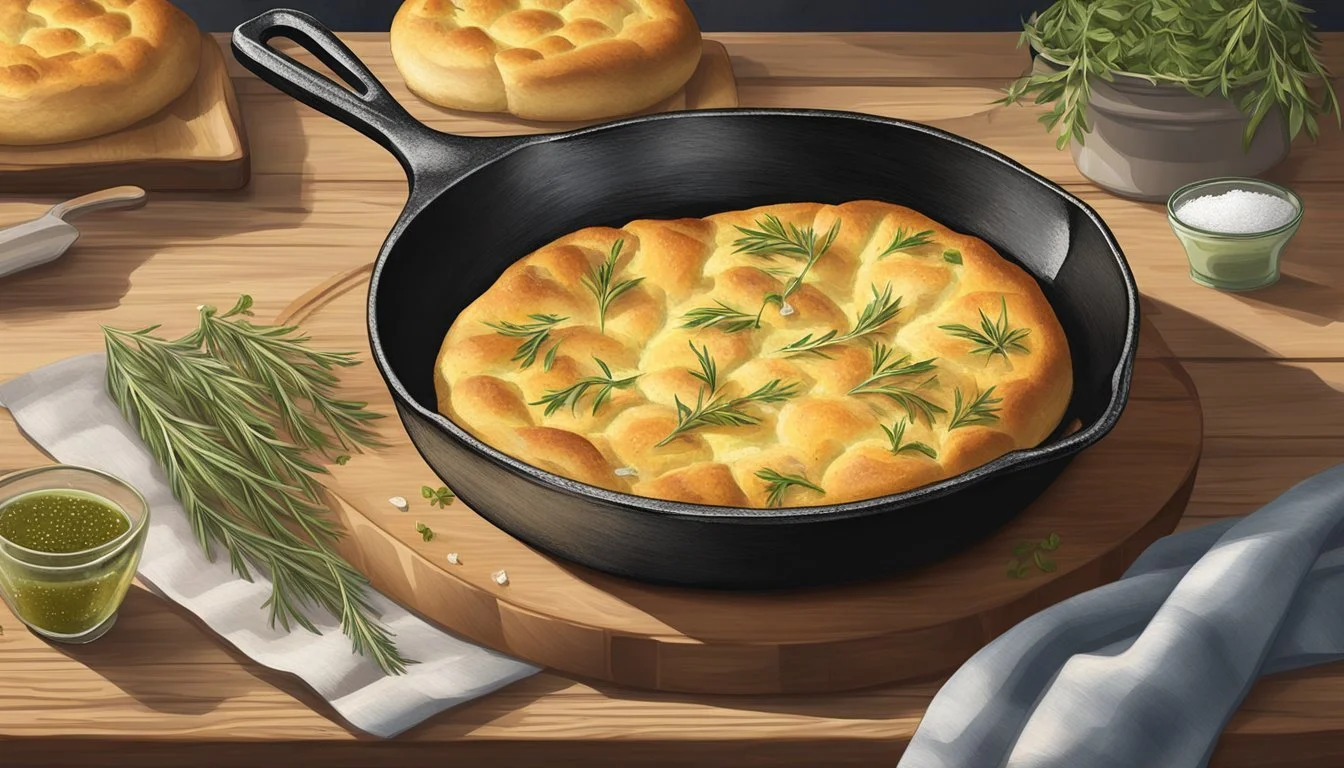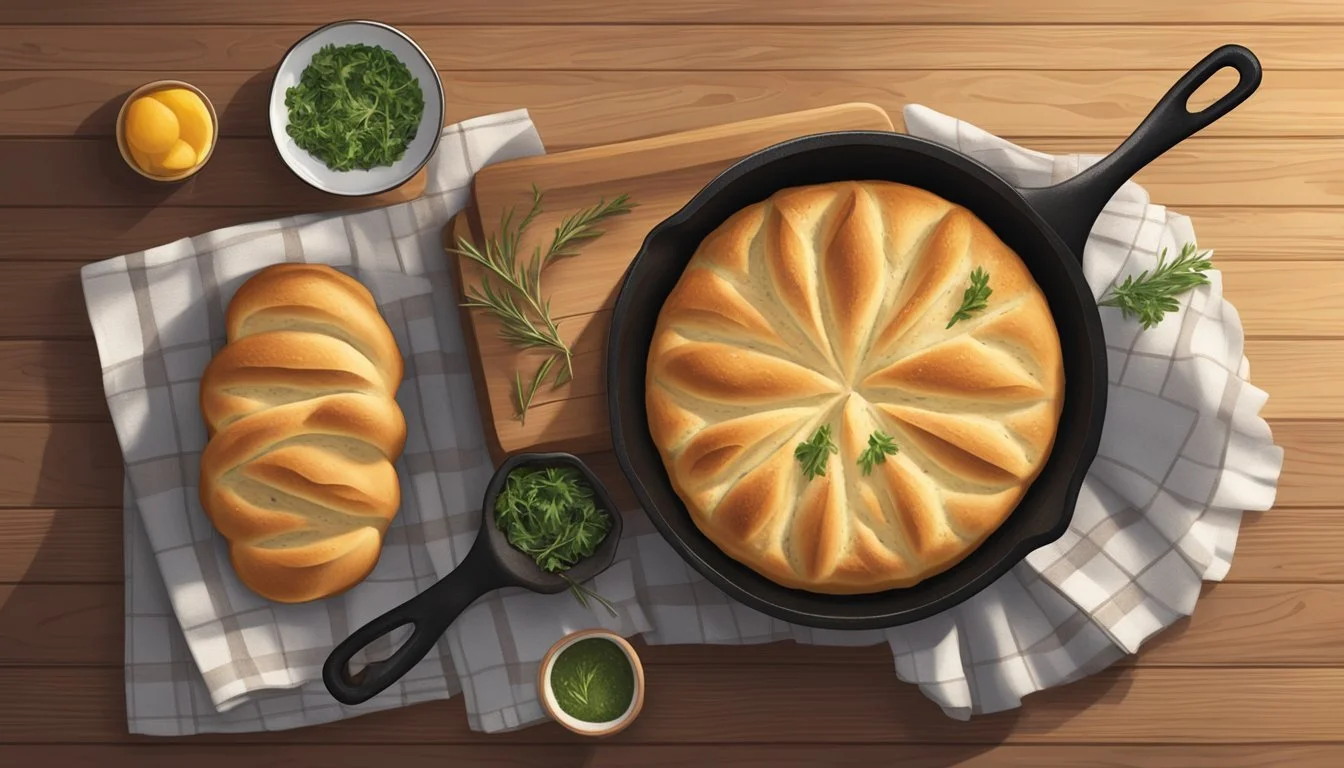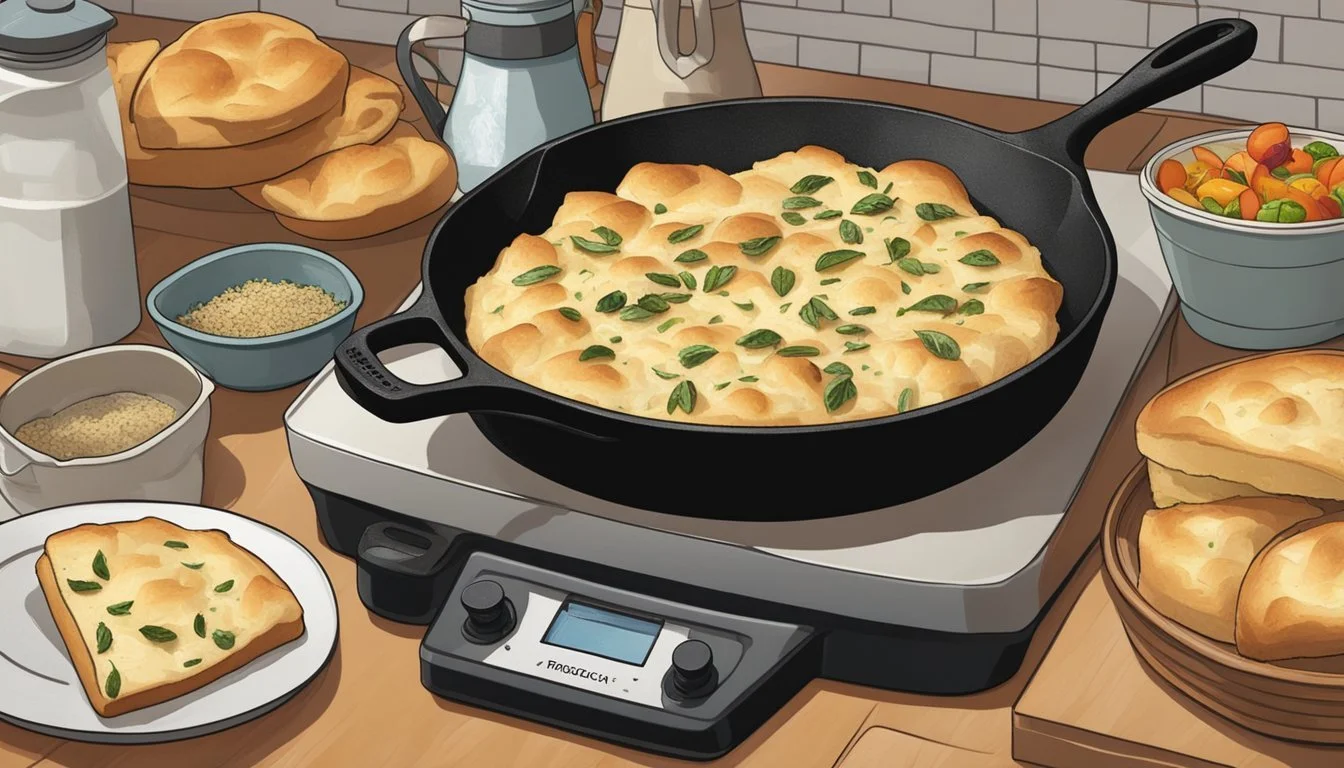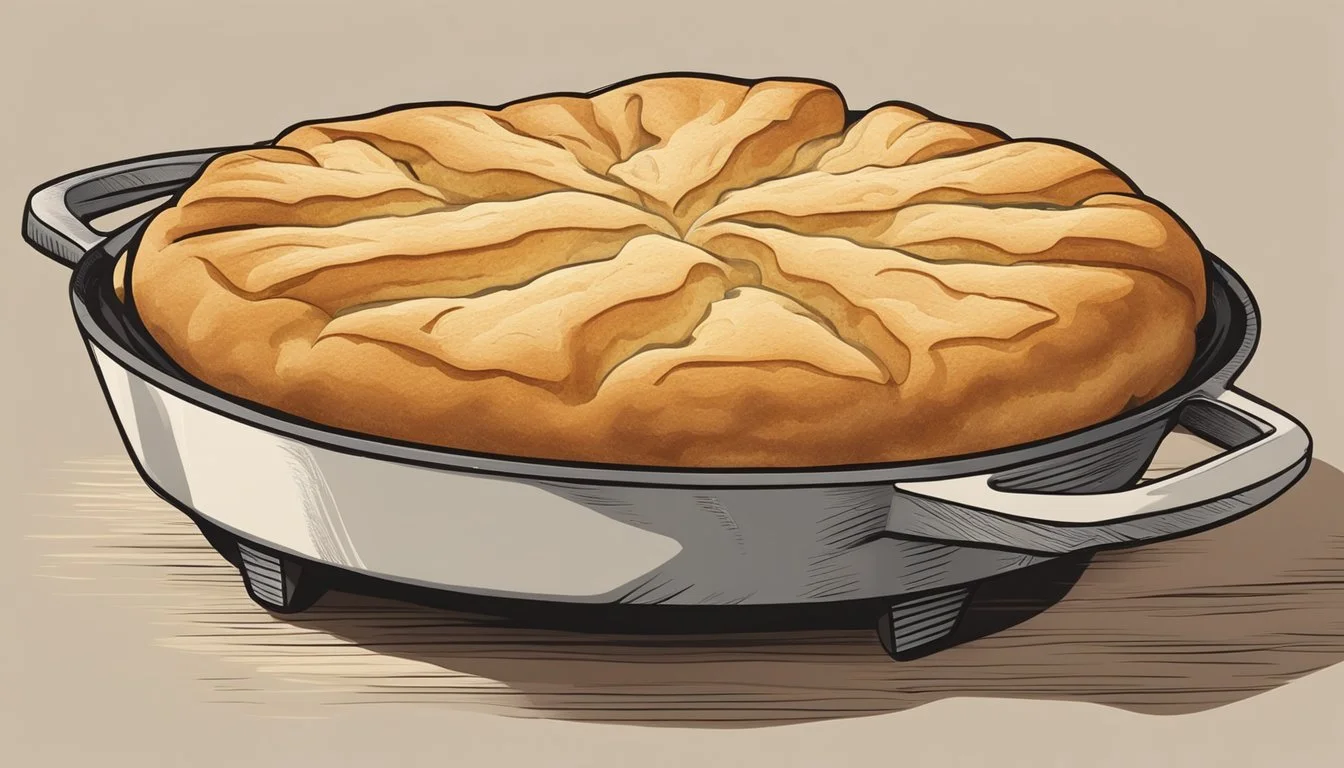The Cast Iron Skillet Focaccia
Perfecting Crust and Fluffiness
The cast iron skillet is not just a staple for searing steaks or baking cornbread (What wine goes well with bread?); it's also an exceptional tool for making focaccia. The heavy, thick metal provides even heat distribution and retention, key factors for achieving a crusty exterior and tender, fluffy interior in focaccia bread. Unlike baking stones that need a high temperature and a long preheat time, cast iron skillets can quickly absorb and transfer heat to the dough, simplifying the focaccia-making process.
Making focaccia in a cast iron skillet also eliminates the need for specialty bakeware, making this artisan bread readily accessible for home bakers. The skillet's seasoned surface acts as a natural non-stick agent, ensuring that the focaccia releases easily once baked. Moreover, the skillet's high sides aid in shaping the dough and give the bread its characteristic height and shape. With the skillet, bakers can achieve a crispy base and a chewy crumb, hallmarks of a well-executed focaccia.
As focaccia bakes, the olive oil in the dough and in the skillet creates a signature rich flavor and a crunchy crust that is hard to replicate with other baking methods. This versatile bread serves as a perfect canvas for a variety of toppings, from simple rosemary and sea salt to a more robust combination of olives, (What wine goes well with olives?) tomatoes, and herbs. The cast iron skillet focaccia thus presents an easy and reliable way to bake bread that is both comforting and impressive.
The Basics of Focaccia
Making the perfect focaccia involves mastering a few essential techniques and understanding the advantages of using a cast iron skillet. This reliable kitchen workhorse evenly distributes heat and can produce a crusty, yet fluffy bread with ease.
Understanding Focaccia
Focaccia, an Italian flatbread, is rich in flavor, primarily thanks to olive oil. Its signature texture is crusty on the outside with a soft, airy interior. The basic ingredients include flour, salt, yeast, water, and olive oil. The dough typically undergoes a rise until doubled in size, followed by a second rise after shaping. Dimpling the dough before baking is crucial; it prevents excessive bubbling and allows oil and toppings like rosemary and sea salt to nestle in, creating a savory crust.
Benefits of Cast Iron Skillets
A cast iron skillet is the home baker's ally in achieving professional-quality focaccia. Cast iron provides consistent heating and excellent heat retention, key for a well-browned and crispy exterior. The skillet's innate nonstick properties, developed through proper seasoning, are ideal for a no-fuss release of the bread after baking. Additionally, a pre-heated cast iron skillet mimics the environment of a baking stone, ensuring that heat surrounds the dough, producing a desirably crisp bottom crust. Using a cast iron skillet also simplifies the baking process, removing the need for special baking stones or equipment.
Starting with Ingredients
The creation of cast iron skillet focaccia begins with selecting quality ingredients, ensuring a crusty exterior and a fluffy interior. The choice of flour, oils, and yeast play pivotal roles in the bread's texture and flavor.
Flour Selection
For the base of focaccia, all-purpose flour or bread flour can be used. All-purpose flour is readily available and yields a satisfactory texture. For a chewier bite and a well-structured crumb, bread flour is preferable due to its higher protein content.
All-purpose flour: suiting a wide range of baking needs
Bread flour: higher protein, perfect for a chewy crust
Oils and Fats
Olive oil is a cornerstone of focaccia, contributing to both the flavor and the moist crumb of the bread. It is used within the dough and also to coat the skillet, creating a crispy bottom.
Extra-virgin olive oil: for mixing into the dough and greasing the skillet
Classic olive oil: a milder option for those preferring less intensity
Yeast and Fermentation
Yeast is crucial for leavening focaccia, with active dry yeast being a common selection. The dough requires a period of fermentation, where the dough rises and develops flavor. Lukewarm water is typically used to activate the yeast, with a small amount of sugar sometimes added to encourage the process.
Active dry yeast: needs activation with lukewarm water
Sugar: not always necessary, but can aid in yeast activation
The focaccia's desirable texture is attained by accurately combining these elements, creating a dough that exhibits a perfect rise and an irresistible aroma in any kitchen.
Preparing the Focaccia Dough
Creating the perfect focaccia dough involves a sequence of steps that ensure the bread's signature texture: a crusty exterior with a fluffy interior. This process does not require kneading, making it accessible even for beginners.
Mixing the Ingredients
The process begins with combining the dry ingredients in a large mixing bowl. A typical focaccia recipe calls for flour, active dry yeast, and salt. They whisk 4 grams of active dry yeast into the flour and integrate about ¾ teaspoon of salt to enhance flavor. Next, they form a well in the center, gradually adding warm water and ½ tablespoon of extra-virgin olive oil. Incorporating these liquids with a wooden spoon or rubber spatula, the mixture is combined until a shaggy dough begins to form. An additional ¼ cup of water may be needed to ensure everything is well hydrated.
The Rising Process
Once mixed, the dough is gently folded, tucking the edges into the center to create a loose ball. No-knead focaccia takes advantage of a long, slow rise, which develops flavor and texture without the effort of kneading. The dough is transferred to a greased bowl, and covered with plastic wrap or a damp dish towel. It then rests in a warm place to rise until doubled in size, typically taking 1 to 1 ½ hours. Using a cast iron skillet for this process is advantageous as it retains an even heat distribution, which is key to the rising of the dough.
Dimpling the Dough
After the dough has risen, it's time to add a defining feature of focaccia: dimples. These are created by pressing down into the dough with oiled fingers, making sure to push all the way to the bottom of the pan. This not only gives the focaccia its characteristic look but also creates little pockets to catch the olive oil, which adds to the flavor and crustiness of the bread. Before baking, additional toppings like rosemary, sliced olives, or flaky salt can be added to enhance the focaccia's flavor. The dimpling technique also helps to distribute the olive oil evenly, ensuring that every bite has a delicious taste and a perfect texture.
Seasoning and Toppings
A well-seasoned cast iron skillet and the choice of toppings are pivotal in creating a perfect focaccia. One can harness the power of herbs and spices to impart a distinct flavor while innovative toppings can transform the classic bread into a gourmet affair.
Herbs and Spices
To elevate the standard focaccia, they often sprinkle sea salt and rosemary on top before baking, creating the quintessential rosemary focaccia. A blend of thyme, oregano, and cracked black pepper brings a more complex flavor profile to the bread. Additionally, using extra-virgin olive oil not only enhances the flavor but also helps in achieving that desirable crispy crust.
Innovative Toppings
As for toppings, the aim is to balance creativity with tradition. Some popular focaccia toppings include:
Olives: Kalamata or green olives provide a briny contrast.
Garlic: Thinly sliced or minced to infuse the bread with a pungent kick.
Parmesan: For a salty, umami-rich finish.
Pesto: Dollops can add a vibrant, herby note.
Artisanal spins: Include items like sun-dried tomatoes, caramelized onions, or roasted red peppers.
Using flaky sea salt rather than kosher salt after the toppings have been added imparts a satisfying texture and a burst of flavor with every bite.
Baking the Perfect Cast Iron Focaccia
Crafting the ideal cast iron focaccia entails a fusion of proper skillet usage, precise temperature control, and meticulous technique to achieve a golden crust. Here are the essentials one needs to perfect this iconic bread.
Using a Cast Iron Skillet
A cast iron skillet is the cornerstone for baking focaccia, offering unparalleled even heat distribution and heat retention. To prepare, one must generously coat the skillet with extra virgin olive oil to prevent sticking and to contribute to the focaccia's crispy bottom. The dough is then spread into the skillet, allowing the oil to envelop it.
Prepare the skillet: Pour 2-3 tablespoons of extra virgin olive oil into the skillet.
Spread the dough: Gently stretch the no-knead dough to the edges of the cast iron pan, ensuring an even distribution.
Heating and Cooking Temperatures
The oven must preheat to a hot temperature, typically around 400°F to 450°F. This high heat is crucial in creating a focaccia with a crispy crust and soft, airy interior. Placing the skillet in a hot oven ensures rapid rise and browning.
Preheat the oven: Set the temperature to 400°F to 450°F before baking.
Baking time: Cook the focaccia for approximately 20-25 minutes.
Achieving a Golden Crust
A golden brown crust with a crispy texture is achievable by baking the focaccia until it visibly browns and using a liberal amount of olive oil. Additionally, creating dimples in the dough prior to baking helps to hold more oil, contributing to the crispness and flavor of the crust.
Monitor the Focaccia: Look for a deep golden brown color as it bakes.
Dimples: Before baking, press down with oiled fingers to form deep dimples across the dough's surface.
By mastering these steps, one can consistently bake a no-knead cast iron focaccia that is both crusty and fluffy, epitomizing the iconic characteristics of this beloved Italian bread.
Serving and Pairing Focaccia
Focaccia, with its crusty exterior and fluffy interior, complements a wide array of dishes. This versatile bread not only adds a touch of Italian flavor to any meal but can also be the star of the show when served with thoughtful accompaniments.
Cutting and Presentation
Once the focaccia has been baked in the cast iron skillet and allowed to cool, it should be transferred onto a cutting board. Using a serrated knife, they can cut the focaccia into squares or wedges, depending on personal preference or serving needs. The rustic charm of focaccia is enhanced when presented on a wooden board, with a spatula nearby for easy service.
Accompaniments and Pairings
Focaccia's versatility allows it to be served in several ways. As a side dish, it pairs excellently with a range of pasta dishes, acting as a vessel to soak up sauces. Alternatively, it can be served as an appetizer, perhaps alongside a fresh salad or a selection of dips.
As Sandwich Bread: Focaccia can be sliced horizontally to create a robust base for sandwiches. The bread’s sturdy texture holds up well to a variety of fillings.
Make Ahead: For convenience, focaccia can be prepared ahead of time, and its flavor often improves as it rests.
Sourdough Variation: Those who prefer a tangier taste may opt for a sourdough focaccia, which not only brings a distinct flavor but also a unique texture to the table.
In terms of specific pairings, the bread’s olive oil-infused crust is complemented by the following:
Accompaniment Description Salads A light, vinaigrette-dressed salad cuts through the richness of focaccia. Charcuterie Cured meats (What wine goes well with cured meats?) and artisan cheeses round out the bread’s flavor profile. Dips Olive tapenade, balsamic vinegar, and roasted garlic offer delicious dipping options.
No matter how it's served or paired, focaccia remains a cherished component in a variety of culinary settings.
Storing and Reheating Leftovers
Handling leftovers properly ensures that the focaccia retains its delightful texture and flavor. This guide will walk through the optimal storage and reheating methods to keep homemade bread tasting fresh.
Best Practices for Storage
One should store leftover focaccia in a way that maintains its crusty exterior and fluffy interior. After the no-knead focaccia bread has completely cooled, wrap it tightly in parchment paper. This ensures that the bread breathes while preventing it from drying out. For additional protection, one might place the wrapped focaccia in a paper bag before storing it in a cool and dry place. This method helps in retaining the bread's quality for up to two days.
Cool: Ensure the bread is at room temperature before storing.
Wrap: Use parchment paper, followed by a paper bag.
Store: Keep in a cool, dry place away from direct sunlight.
Reheating for Freshness
When reheating focaccia, the goal is to revive its satisfying crust without sacrificing the moist interior. Preheat the oven to 350 degrees Fahrenheit. Lay the focaccia on a baking sheet and lightly sprinkle the top with water, which assists in keeping the bread moist. Cover it loosely with foil to prevent over-browning. Heat for approximately 10-15 minutes, checking occasionally. The bread should emerge with a crisp bottom and a top that's as moist as when it was first baked.
Preheat Oven: 350°F is ideal for reheating.
Moisture: A light sprinkle of water can help.
Cover: Use foil to avoid excess browning.
Heat: About 10-15 minutes or until thoroughly warm.
Advanced Tips and Variations
For those ready to elevate their cast iron focaccia, precision and creativity can significantly enhance the final product. Using a digital scale for ingredients and experimenting with different flavors and textures will yield consistently superior results.
Alternative Ingredients
To start, consider the base of the focaccia. Traditional recipes often call for instant dry yeast, but one can achieve a more complex flavor profile with a sourdough starter. It's important to use room temperature water to activate the yeast or to maintain the starter, ensuring the right environment for dough development.
One can also swap out regular flour for specialty flours, which can slightly alter the texture and taste. While Parmigiano-Reggiano cheese offers a deeply savory note, adding it directly into the dough can enrich the flavor. Weighing ingredients using a digital scale ensures accuracy and can make a significant difference in the dough's consistency.
Creative Flavors and Textures
The versatility of cast iron focaccia bread allows for an array of creative toppings that can be adjusted according to personal preference. Fresh herbs, such as fresh rosemary, infuse a classic aromatic touch. For a burst of tangy sweetness, sun-dried tomatoes can be kneaded into the dough or sprinkled on top before baking.
The crust's texture, akin to a thick pizza crust, can be adjusted by simply altering the olive oil amount and baking time. Using one's fingers to create deep dimples in the dough helps retain pools of olive oil, enhancing the focaccia’s moistness.
Sprinkling flaky salt on top adds a subtle crunch and seasoned finish, but be mindful of the quantity as it should complement rather than overpower the other flavors.
By embracing these advanced tips and variations, bakers will find that cast iron skillet focaccia is not just a bread – it's a canvas for culinary creativity and precision.
Nutritional Information and Health Benefits
When baking focaccia in a cast iron skillet, the result is not only delightfully crispy and fluffy but also carries with it a range of nutritional benefits, from macronutrients to essential vitamins and minerals.
Caloric Content
A single slice of homemade focaccia bread typically contains a moderate amount of calories, largely dependent on the ingredients and portion size. If one adheres to a focaccia bread recipe using olive oil and fresh tomatoes, for instance, it's important to note that olive oil, while healthy, is calorie-dense. The addition of ingredients like cheese or cured meats will further increase the per-slice calorie count.
Beneficial Nutrients
The nutritional profile of focaccia bread boasts a variety of vitamins and minerals. Essential nutrients such as calcium, phosphorus, potassium, and sodium are present, and the bread is often a good source of B vitamins like folate, thiamin, niacin, and selenium — the latter of which supports immune function and thyroid health.
Folate: One slice can provide almost 20% of the recommended daily intake.
Selenium: Works as an antioxidant and supports metabolic function.
Yeast, a fundamental bread ingredient, facilitates not just the rise of the dough but also enhances the bread's nutritional value. Olive oil, a heart-healthy fat, contributes monounsaturated fats and can help with the absorption of vitamins. Fresh tomatoes, when used as a topping, add a burst of flavor as well as lycopene, an antioxidant, and additional vitamins A and C.
Exploring Focaccia's Culinary Versatility
Focaccia, a beloved Italian bread, serves as a canvas on which a multitude of global flavors can be painted, transforming it from a simple side to a sophisticated staple suitable for both casual and gourmet settings.
Global Adaptations
In its essence, focaccia is an Italian bread known for its olive oil-rich crust and airy interior, yet it has been adopted and adapted by cuisines worldwide. A quintessential example is the use of kalamata olives and cherry tomatoes, which can be embedded into the dough prior to baking, offering a Meditteranean twist to the classic Italian version. Other global variations include topping focaccia with sliced potatoes, a hint of lemon zest, or even a drizzle of honey for a sweet and savory play on flavors.
From Casual to Gourmet
Focaccia's versatility extends from everyday casual meals to fine dining experiences. A simple dimpling of the dough followed by a sprinkle of fresh rosemary can accompany a rustic picnic. Conversely, for a more gourmet approach, chefs might top the bread with layers of fresh tomato and mozzarella, or a delicate arrangement of sliced tomatoes, transitioning the humble focaccia into an elegant dish that could grace the tables of high-end restaurants. The key to focaccia's gourmet elevation lies in the quality of ingredients and the creativity of its toppings, allowing this Italian classic to stretch across a diverse culinary spectrum.
FAQs About Cast Iron Skillet Focaccia
What is cast iron focaccia?
Cast iron focaccia is a variation of the traditional Italian bread known as focaccia, which is baked in a cast iron skillet. The skillet provides an evenly heated surface, resulting in a crusty exterior and a fluffy interior, mimicking the effect of a baking stone.
Does the cast iron skillet require special seasoning for baking focaccia?
Yes. A well-seasoned cast iron skillet ensures the focaccia doesn't stick and promotes even browning. Season the skillet regularly by coating it with a thin layer of oil and heating it in the oven.
What type of yeast is best for homemade focaccia?
Active dry yeast is commonly used for homemade focaccia. It should be activated in warm water before being added to the flour mixture. Yeast is essential for the dough to rise, creating the characteristic air pockets.
Can I add toppings to my focaccia?
Absolutely. Common toppings for focaccia include black olives (pits removed), coarse sea salt, and rosemary. For best results, add them just before baking to prevent sinking into the dough.
Is extra virgin olive oil necessary for focaccia?
Extra virgin olive oil is recommended for its flavor and ability to withstand the high heat of the oven. It's mixed into the dough and also used to coat the top before baking.
How does baking in a cast iron skillet compare to a baking stone?
A cast iron skillet is an excellent alternative to a baking stone. It retains and distributes heat evenly, providing a consistent temperature that is crucial for a well-baked focaccia.
Should I remove the focaccia from the skillet immediately after baking?
After baking, let the focaccia rest in the skillet for several minutes to complete the cooking process from residual heat. Afterwards, transfer to a cooling rack to prevent the bottom from becoming soggy.









